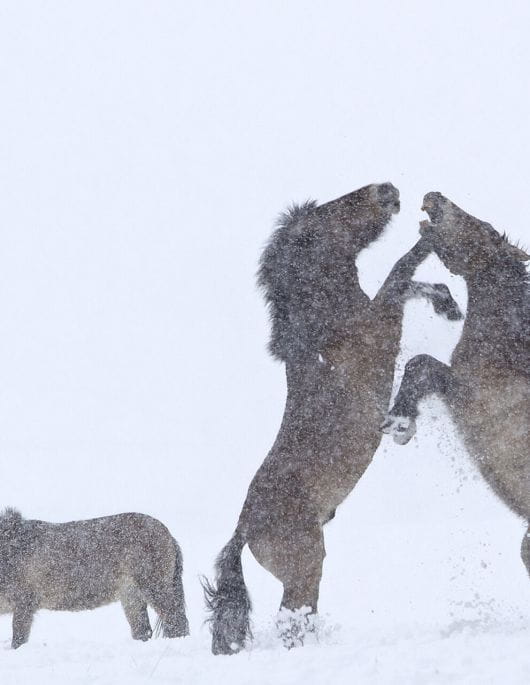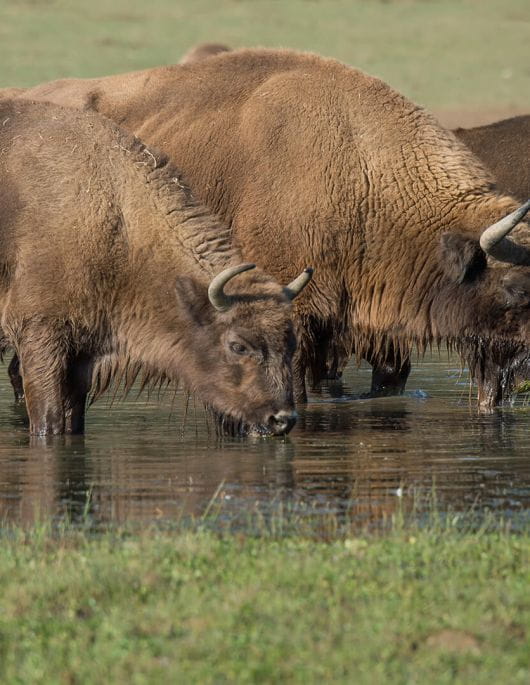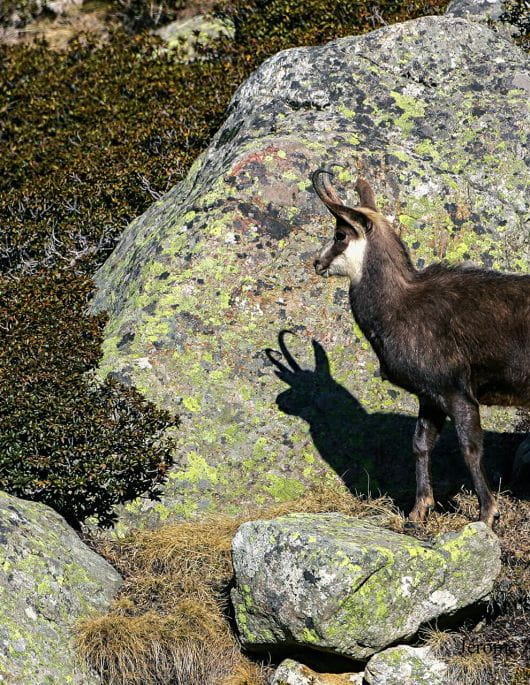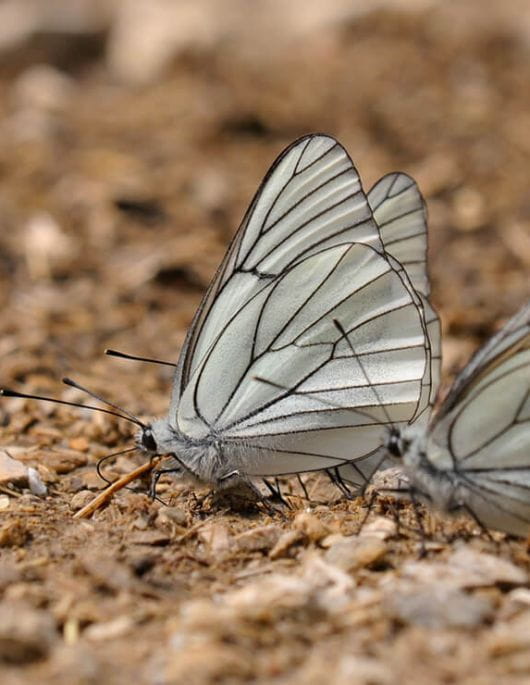The return of the wild in France
It’s about time France recovered its lost species…
Today, twelve centuries after its disappearance from Mediterranean forests, Europe’s largest mammal is finally back. The European bison is once again living happily on the plains and in the forests of Thorenc.
In 2005 and 2006, Aléna and veterinarian Patrice Longour brought back two groups of magnificent specimens from the Bialowieza forest (Poland), their last European refuge. At the same time, Aléna acquired several Przewalski’s horses from various European zoos to release them on the Reserve. This valiant little horse, which adorns the walls of many Cro-Magnon caves, is the only one to have remained completely wild. Man has never managed to tame it!
The Monts d’Azur Reserve is the only place in Europe where the European bison and
Przewalski’s horse are once again living together.
These two emblematic species that man had virtually exterminated are once again reunited on a territory they share with deer, roe deer, chamois, wild boar, foxes, wolves, lynx and many other species. Wild and free!
No one before us had dared to organise this reunion. But we did. It’s one of the most exciting ecological experiments in Europe today.
The origins Man and animal: an eternal alliance
We have often been accused of wanting to acclimatise the European bison and Przewalski’s horse on La Réserve, two animals that would have no legitimacy to live in France, and in particular in the Alpes-Maritimes. The bison, we are told, is an animal of the great forests of Eastern Europe, while the wild horse is a steppe dweller. Still others claim that French biodiversity has nothing to gain from these two species.
We kindly and firmly reply to these contradictors that they are doubly wrong.
One: you only have to look at cave paintings to see that bison and Przewalski’s horse were regular visitors to our regions not so long ago. If, in historical times, they found refuge in extreme environments, it was because they were forced to do so. In fact, to escape human pressure.
Two: large herbivorous species play a vital role in revitalising environments and dramatically increasing their resilience; which is always an excellent thing for biodiversity.
But let’s take a step back to understand how closely the history of humanity is linked to that of animals, and how dangerous it would be to break this link.
Subsistence hunting to survive the Ice Age…
Ever since they first appeared on earth, humans have been scavengers or hunters. At Tautavel, the oldest remains indicate that they were already hunting reindeer 550,000 years ago…
Half a million years later, Homo sapiens arrived in Europe at the height of the Ice Age. They gradually conquered the whole of Western Europe. To survive, they had to hunt like Neanderthals, with whom they cohabited. Mammoths and woolly rhinoceroses, megaceroses (large deer), cave bears, panthers, as well as reindeer, elk, wild horses and bison priscus, the ancestor of today’s bison, were all sought-after game. The fauna at that time was therefore very different from the one we know today*¹.
When the Ice Age came to an end 30,000 years later, the great expanses of steppe and tundra gave way to immense forests of pine and birch. The fauna underwent a complete transformation.
*1: Françoise Delpech – The animal environment of Europeans in the Upper Palaeolithic

Extinctions and migrations
Some species are disappearing for good, such as the woolly mammoth and rhinoceros, the cave bear and hyena, the megaceros… Others migrate south, such as the European wild ass and the panther, or north, such as the reindeer, the musk ox, the saiga antelope, the polar fox and probably Przewalski’s horse (Equus férus przewalskii).
However, most of these species stayed put and found favourable conditions for their expansion into present-day Western and Central Europe. Wild boar, red deer, elk, roe deer, ibex, chamois and aurochs shared their territory with a newcomer, the European bison (Bison bonasus), which appeared around 12,000 BC.
Perhaps more cautious than Neanderthal*², Cro-Magnon appears to have diversified his prey, including small ungulates such as ibex and chamois and small game. He did not, however, abandon large ungulates. Herds of reindeer and wild horses provided large quantities of meat. Neanderthal hunting techniques were adopted and tools improved. Around 10,000 BC, the first bows and arrows appeared in Europe.
*2: Jean-Jacques Hublin – Max Plank Institute
When hunting gradually gave way to animal husbandry…
The first major revolution in the relationship between man and animal came in the Arctic, where nomadic hunter-gatherers managed to domesticate the wolf around 12,000 BC. The wolf immediately became a valuable partner for the hunter in his quest for food. Until the Neolithic period (which began around 9,000 BC in the Middle East), human populations were essentially nomadic hunter-gatherers. Their survival depended heavily on the presence of herds of herbivores. Following the migrations and hunting was an obligation. Sedentarisation was to change this relationship.
Around 10,000 BC, Cro-Magnon found favourable conditions for long-term settlement around the Nile delta and the great rivers of Mesopotamia.
Under this human pressure, wildlife had no alternative but to
go deeper into the remaining forests or flee
The clearings were extended by burning and uprooting. The edges are grazed by newly domesticated species. Under this pressure, the wild fauna has no alternative but to move deeper into the remaining forests or to flee imperceptibly towards the north of the continent, where there is still little human presence.

When livestock farming leads to the disappearance of wild ungulates
When the Neolithic Revolution spread throughout Europe around 3,300 BC, the majority of large ungulates (European bison, aurochs, elk, red deer, wild horse) were still well represented.
Only the wild donkey (Equus hydruntinus) had declined significantly, with its range limited to southern Europe and the Middle East.
Two thousand years later, the natural landscape has changed even more profoundly. The intensification of agriculture and livestock farming contributed from Antiquity (2000 BC) to the crumbling of the immense primary forests that had emerged after the Ice Age. Massive forest clearance continued until the end of the Middle Ages (1500 AD).
At the end of the 9th century, the French primary forest still survived in the Ardennes and Vosges, sheltering the last bison and aurochs.
At the beginning of the 17th century, the only significant remaining primary forest in Europe was in Poland and Belarus. The Bialowieza Forest still covered 2,500 to 3,000 km². It was the last European refuge for large herbivores: tarpan, bison, aurochs, elk
Large fauna in Europe paid a heavy price for the development of
agriculture and livestock farming
.
Large fauna
the objectives pursued by the scientific team
In the end, large fauna in Europe paid a heavy price for the development of agriculture and livestock farming. Unlike on the African continent, large species were very early on seen as competition to be eliminated.
Three large species disappeared for good: the wild donkey in the 15th century in Spain, the auroch in the 17th century and the Tarpan in the 18th century in Poland. Three others came close to extinction: the European bison, Przewalski’s horse and the brown bear. They are now only represented by a few relict populations, most often scattered in sparsely populated areas.

From the programmed disappearance…
Europe has definitively lost three of its five major ungulate species: the aurochs, the tarpan and the wild donkey, while the bison now has only a very restricted range (Poland, Belarus and perhaps the Caucasus). Only the elk can still roam vast expanses of Scandinavia and Russia.
For the smaller species, deer, chamois, roe deer, ibex and even wild boar, the situation was hardly any better in France before 1950.

…The return of small ungulates
Since then, the abandonment of agriculture has encouraged the expansion of forests and the return of these herbivores and their predators, particularly in mountainous areas.
According to the Office National de la Chasse et de la Faune Sauvage, there are 70,000 chamois, 30,000 isards and 8,000 ibex in the mountain parks and 150,000 deer in the country’s forests, with major regional disparities.
While this increase in numbers is to be welcomed, the fact remains that our country has a natural area capable of supporting a deer population probably in excess of one million (La lettre de Forêts sauvages – G. Cochet – Octobre 2008).
As for the chamois, ibex and mouflon populations, they could easily be doubled in the national parks if they were not subject to unfair competition from domestic herds.

Wildlife, a forgotten resource!
Wildlife remains a forgotten resource by the authorities, in France as in most European countries. There is no large-scale project to integrate it into territorial development plans. Its legal status is uncertain and its “management” is carried out by a set of actors with contradictory interests: hunters, farmers, foresters or ecologists. However, wildlife is a major and essential player in the dynamics of natural spaces.
There are no large-scale projects to integrate wildlife into land use plans